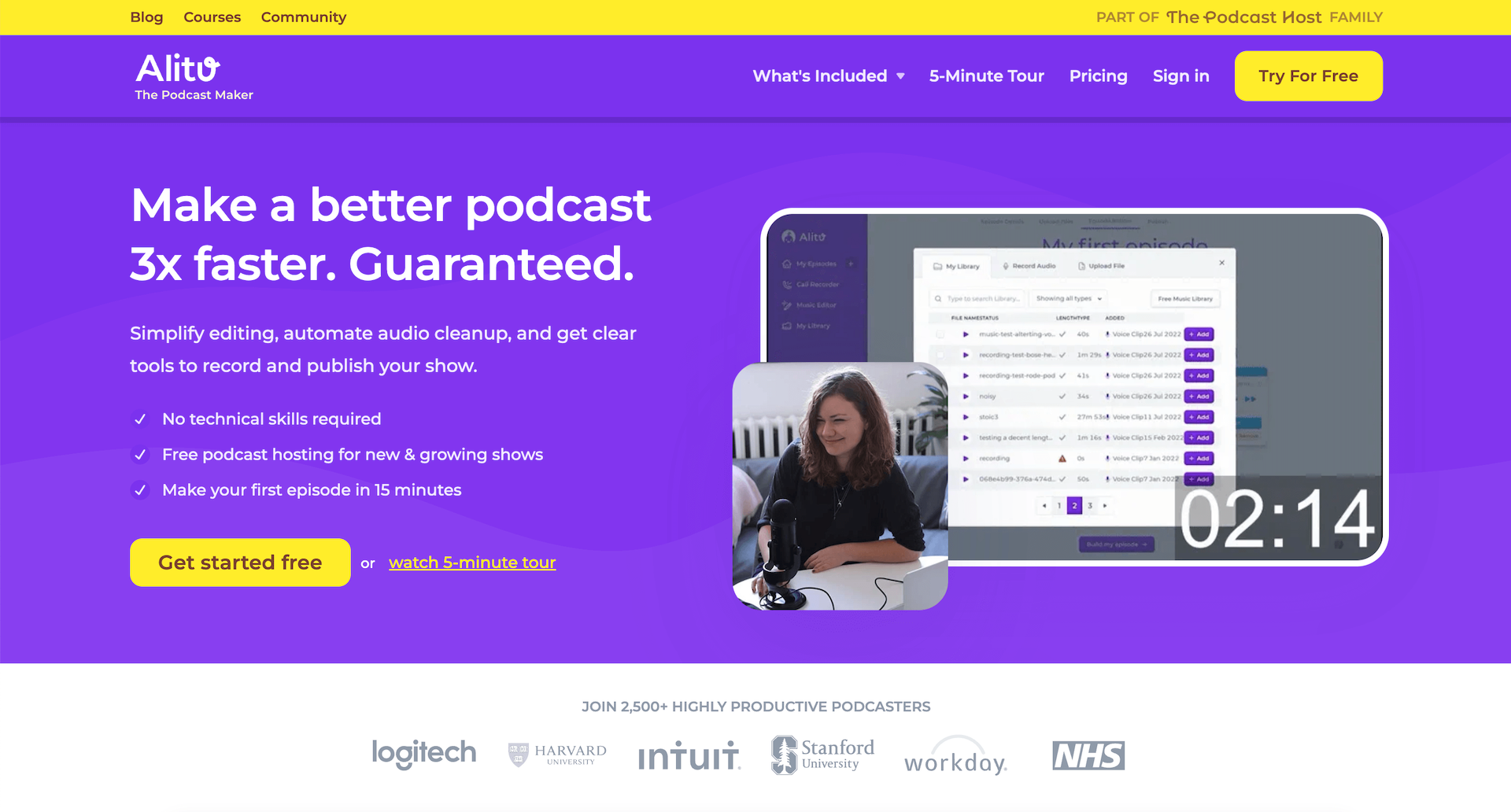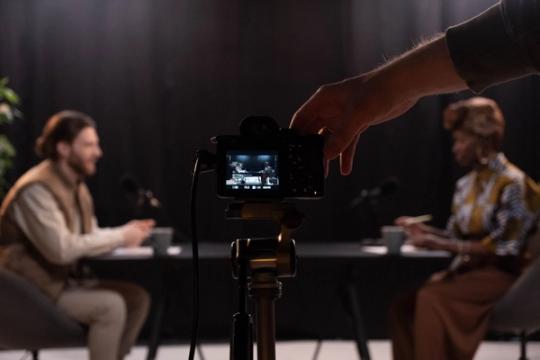
Are you looking to start your podcast journey, but unsure on which software will best suit your needs? Well we've reviewed our top picks, with our easy-to-follow recommendation guide below.
Today, it seems like every man and their dog has a podcast. With thousands of episodes being released daily, you can seemingly find a podcast on any subject matter. With the sheer popularity and meteoric rise of the podcast, comes an ever-increasing number of resources, services and software programs. This level of competition has made it both incredibly easy and cheap to launch a podcast on your own. That said, the sheer volume of recording and editing software out there can make it incredibly overwhelming to know where to start.
There are countless methods and paths you can take to start on your podcast, but all of them at some point will involve choosing the right software to both record and edit your podcast episodes. That's why we've selected the best podcast recording software and reviewed each of them for you below.
Our Top Picks
1. Alitu

Alitu is an all-in-one podcast editing tool with a unique and easy-to-use ‘drag and drop’ editor. It's advanced technology not only allows you to edit your podcasts with a very simple graphical interface, but it will also automatically optimise and equalise your podcasts audio tracks. Built for beginners, yet still powerful enough to handle all your editing needs - including soundtracks, music, intros/outros and automatic distribution.
Pricepoint
- Pricing starts at $28 per month
- No free plan exists, however it does come with a free 7-day trial.
Web or Application Based
- Web-based
Learning Curve
- Low. Built for beginners, you'll get up and running in no time.
Features
- Drag-and-drop visual editor
- Leave the audio optimisation and technical nitty-gritty to AI. Handles noise reduction, compression and equalisation all happens automatically.
- Automatic audio distribution.
- Automatically separates tracks per guest.
- Manage monetization and your advertising within the software.
- Record group calls.
Cons
- Lesser granularity and control over audio, since AI handles it all automatically.
2. Zencastr
Zencastr is an all-in-one podcasting platform. It bundles together recording, editing and distributing - making it one of the easiest solutions to handle all of your podcasting needs.
Pricepoint
- Pricing starts at $20 per month
- A free plan exists, however only with limited features. You'll need to upgrade quite quickly to get the most out of it.
Web or Application Based
- Web-based
Learning Curve
- Low to medium. Most users will be able to get up and running easily with Zencastr, and no knowledge of advanced audio engineering is required. Built for beginners,
Features
- 16-bit 48k WAV Audio.
- Record video in 4K.
- Unlimited automatic audio distribution.
- Automatically separates tracks per guest.
- Manage monetization and your advertising within the software.
3. Ringr
Ringr is strictly a podcast recording tool, and although it doesn't have many editing features per-say, it has to be mentioned due to its ease-of-use in the remote interviewing space. The Ringr app makes it incredibly easy to record long-distance interviews, where the app will automatically start recording when a guest joins. The app then merges audio files and automatically edits and optimises them.
Pricepoint
- Basic plan starts at $8 per month, however for studio-level audio quality, you may want to upgrade to the premium tier for $19 per month.
Web or Application Based
- App-based
Learning Curve
- Low. You could teach a monkey to use this app. Nearly everything happens automatically.
Features
- Easy remote interview recording.
- Automatic audio optimisation and normalization
- Automatically merges audio files of you and your guests.
Cons
- No audio editing tools, so if you need to remove sections, you'll have to do this with another production tool or service.
- Audio quality of basic plan leaves a lot to be desired. You'll need to upgrade to the premium plan to get professional quality.
4. Audacity
Audacity is one of the original podcast editing tools, and it has been around for decades. It is one of the only free, open-source tools out there and has very thorough documentation because of its widespread use. Audacity lets you choose the quality of your audio - whether that be 16-bit, 24-bit, or 32-bit. It consists of multitrack support and has all the features you'll need for a to start you off. Audacity has a slightly steeper learning curve and you'll probably need to do a couple YouTube tutorials to make sure you understand how to get the most out of the software.
Pricepoint
- Completely free.
Web or Application Based
- Application based, Microsoft, Apple and Linux options.
Learning Curve
- Medium. Although not as steep as a fully-fledged editing suite like Adobe Audition, Audacity will still require a small amount of research and basic tutorials to get up to speed.
Features
- Software runs on all operating systems.
- Select between 16-bit, 24-bit, or 32-bit recordings.
- Fantastic, comprehensive music effects library.
- Large variety of recording functionality, for free.
Cons
- Somewhat outdated UI.
- Slightly steeper learning curve then some of the other very intuitive tools on this list.
- More advanced audio productions studios may need something with some more editing features.
5. Adobe Audition
Adobe Audition is one of the highest-grade podcast editing tools out there. It could more accurately be classified as a DAW, or a Digital Audio Workstation, however we have included in this list to give you some oversight into the more advanced options. It is typically what many professional agencies will use, however it is still somewhat affordable for individuals or hobbyists. If you're looking for the most features, advanced compression, batch processing, and the highest audio recording, then look no further than Audition. All of this functionality doesn't come without a tradeoff, and that is that Audition has a relatively steep learning curve and high (-ish) monthly price.
Pricepoint
- $21 per month as a standalone service. Otherwise it is included in the Adobe suite, if you already have a subscription. There is also a free trial available.
Web or Application Based
- Application based, Microsoft & Apple.
Learning Curve
- Medium to High. Given that Adobe Audition is a fully-fledged recording and editing powerhouse, you will need to take some tutorials to understand how to get the most out of it.
Features
- Professional-grade audio recording and editing features.
- Simultaneously mix up to 32 tracks.
- Smart reverb, denoise/noise normalisation and mixing functionality.
- Ample documentation, given that it's an Adobe product.
Cons
- Some podcasters may find the sheer number of audio features overwhelming, especially for basic podcasting needs.
- Steep learning curve.
- On the expensive side if you don't already have an Adobe Suite membership.
- Not purpose-built for podcasting specific functionality, so won't include things like automatic platform distribution.
6. Garageband
We can't mention Adobe Audition without Apples' free DAW, GarageBand. Technically the software is aimed at musicians, rather than podcasters, but it still consists of all the functionality you would need to put together a high-quality podcast. Garageband consists of multi-track support and an easy to use visual interface with a tonne of built-in functionality.
Pricepoint
- FREE!
Web or Application Based
- Application based, Apple only.
Learning Curve
- Medium. One of the easier DAW to get up and running with. Although it has ample advanced audio functionality, Apple have done a great job at making it as easy to use as possible. You would have to take a couple YouTube tutorials to understand the basics, but there's no reason you can't be recording and editing within a day.
Features
- Professional-grade audio recording and editing features and tools.
- Clean, modern UI.
- Has been around for decades, so solid documentation, and world-class Apple support.
Cons
- Not built for podcasting, so lacks some nice-to-have features like multi-guest support, split track recording or automatic distribution.
- Moderate learning curve.
- Not built for Windows.
7. Iris
Iris is the new kid on the block when it comes to podcasting recording software. It has made a huge impact on the market and boasts a customer base of over 10,000 podcasters already. The tool markets itself as an incredibly simple and powerful piece of software, and after we used it briefly, we can see why. It boasts superb video and audio quality, seperate track recording and the ability to simply record in the browser, so no annoying downloads are required by your guests.
Pricepoint
- Starts at $9 per month, however this will only get you 2 hours worth of recording. $19 will get you 5 hours, and $29 will get you 10 hours each month.
Web or Application Based
- Application based, Apple only.
Learning Curve
- Low. Built specifically for podcasters, the UI is clean, modern and incredibly intuitive.
Features
- Very effective and popular in producing remote interviews.
- Inviting guests is super easy. No need to ask them to download anything, as they can simply join via a URL.
- Quick and helpful technical support.
- Low learning curve.
Cons
- Somewhat more expensive that other items in the list, especially if you're producing over 10 hours of recordings each month. But this typically won't be an issue for most.
8. Zoom
Although we wouldn't normally recommend Zoom for podcasting, it is a great way to start for free and get familiar with the process. Nearly everyone has used Zoom so it provides a great starting point. Zoom provides an easy way to seperate audio and video files however the quality of the both will be inferior to the rest of the options on this list. Regardless, it can be a great starting point, to get familiar with interviewing and working with audio and video files.
Pricepoint
- FREE!
Web or Application Based
- Application based, Microsoft & Apple.
Learning Curve
- Low. Built for conference calls. A program that the entire world is familiar with.
Features
- Get up and running instantly, use Zoom to test out recording for free.
Cons
- Not built for podcasting, so will have inferior audio and video quality. Will also not consist of any podcast specific features, like automatic audio normalisation, distribution or a music effects library.
- No editing built in, so you will need to edit your podcast with another tool.

